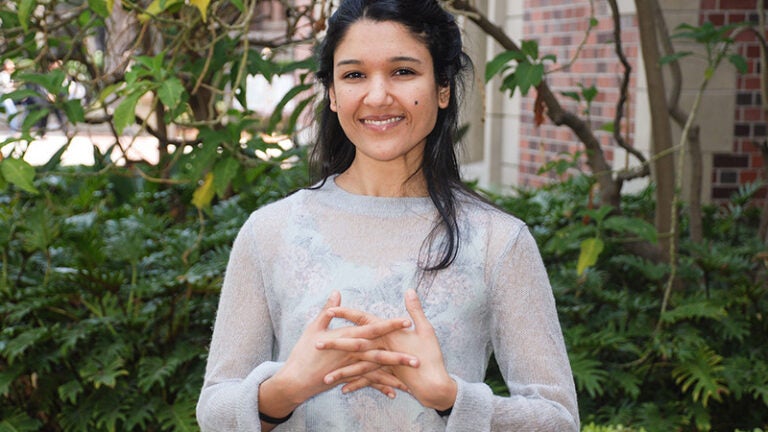
Molecular biology Ph.D. graduate makes all the right moves
Growing up in New Delhi, Pragya Goel often would ask her parents about her name.
She knew that most parents gave their children a first name that means “happiness” or that was related to the weather. Some would choose a name that had to do with their baby’s appearance or was based on an Indian mythological deity.
The Indian meaning of Pragya is “wisdom” or “knowledge.”
“I would ask them, ‘What made you think that you should name a baby ‘Knowledge?’” Goel recalls. “It’s a very unique name.”
Maybe her parents knew something back then.
When Goel attends the Ph.D. Hooding Ceremony this week, she’ll receive her degree as one of USC Dornsife College of Letters, Arts and Science’s most acclaimed and decorated doctoral students.
Earning a Ph.D. in molecular biology, she’s the first author on five papers published or in press, and a contributing author on four others — scholarly productivity her faculty advisor, Dion Dickman, calls “breathtaking.”
Among Goel’s numerous awards and honors, she received the Harrison M. Kurtz Memorial Award for most outstanding student in biological sciences as well as the USC Ph.D. Achievement Award.
Writing in support of Goel to be considered for the latter, Dickman, assistant professor of biological sciences, noted she already has an international reputation as a rising star in neuroscience.
As a geneticist, microscopist, electrophysiologist and quantitative biologist, Goel has developed, by herself, new imaging approaches that have revealed dynamic changes in synaptic structure and function that Dickman believes will transform the field of synaptic plasticity, he wrote.

Pragya Goel studies plasticity in nerve synapses.
Synaptic plasticity refers to the ability of the synapses — the gap across which nerve cells communicate — to strengthen or weaken over time in response to changes in their activity.
“Basically,” Goel explains of her work, “we want to reveal or discover new genes and molecules and mechanisms that control the process of how synapses adapt to maintain nervous system stability during development, aging and in response to experience. One reason, of course is get a better understanding of neuropsychiatric diseases, such as schizophrenia, autism and depression, but also to understand complex and enigmatic processes of learning, memory and sleep.”
Almost a dancer
When she was younger, Goel considered pursuing ballet as a profession. But the tug of academia, as well as the advice of her parents (Goel’s father is a physician and her mother is a psychologist), and even her own personal goals, kept her head in the books.
Always great in science, she was fascinated with Hollywood science fiction movies, especially the ones using memory as a plot device. This passion transformed into a deep interest in how the mind works— the minutiae of what makes it tick.
Goel earned her undergraduate degree in computer and electrical engineering at Netaji Subhas Institute of Technology at the University of Delhi. But unlike most of her fellow students, she wasn’t a huge fan of staying up all night to write computer code or of computer engineering itself.
Goel’s fertile brain was drawn to applied areas, such as how machine learning and algorithms can be harnessed to predict what a sequence of amino acids — the building blocks of proteins — would look like. In 2011, that interest led her to Cornell University in New York, where she earned a master’s degree in computer science.
Goel once again switched gears, realizing her true passion was computer science and computational neuroscience after working in a brain imaging lab in 2012. While there, she earned a travel grant to the Allen Institute for Brain Science in Seattle to participate in a hackathon centered on using big data in neuroscience. Despite receiving job offers from Goldman Sachs and Microsoft, she made a firm decision to join a Ph.D. program and commit to more research.
An outlier student
Remo Rohs, professor of biological sciences, chemistry, physics and astronomy, and computer science at USC Dornsife, recruited Goel after meeting her during a visit to the Indian Institute of Technology Delhi, where Goel was working on her undergraduate thesis project.
But a summer rotation in Dickman’s lab moved her toward experimental work.
“I feel extremely fortunate to have such supportive mentors who encouraged me to pursue my passion,” she says. “Usually you would want to stick to one thing after you’ve decided [your academic specialty], but it was exciting to explore a wide range of scientific interests early on.”
Dickman clearly counts himself fortunate Goel joined his lab.
“I can state without equivocation,” he wrote in his recommendation letter, “that [Pragya] is the best graduate student I have come across not only here at USC, but in my years of training at Harvard University and the University of California at San Francisco.”
In mid-November, Goel will begin postdoctoral work at Harvard University.
“What excites me about being a scientist is the opportunity that it provides to use my innate curiosity, creativity and imagination to discover a yet-unknown and unexplored facet of life,” Goel says. “My dream is to be a professor and run my own lab in academia one day.”